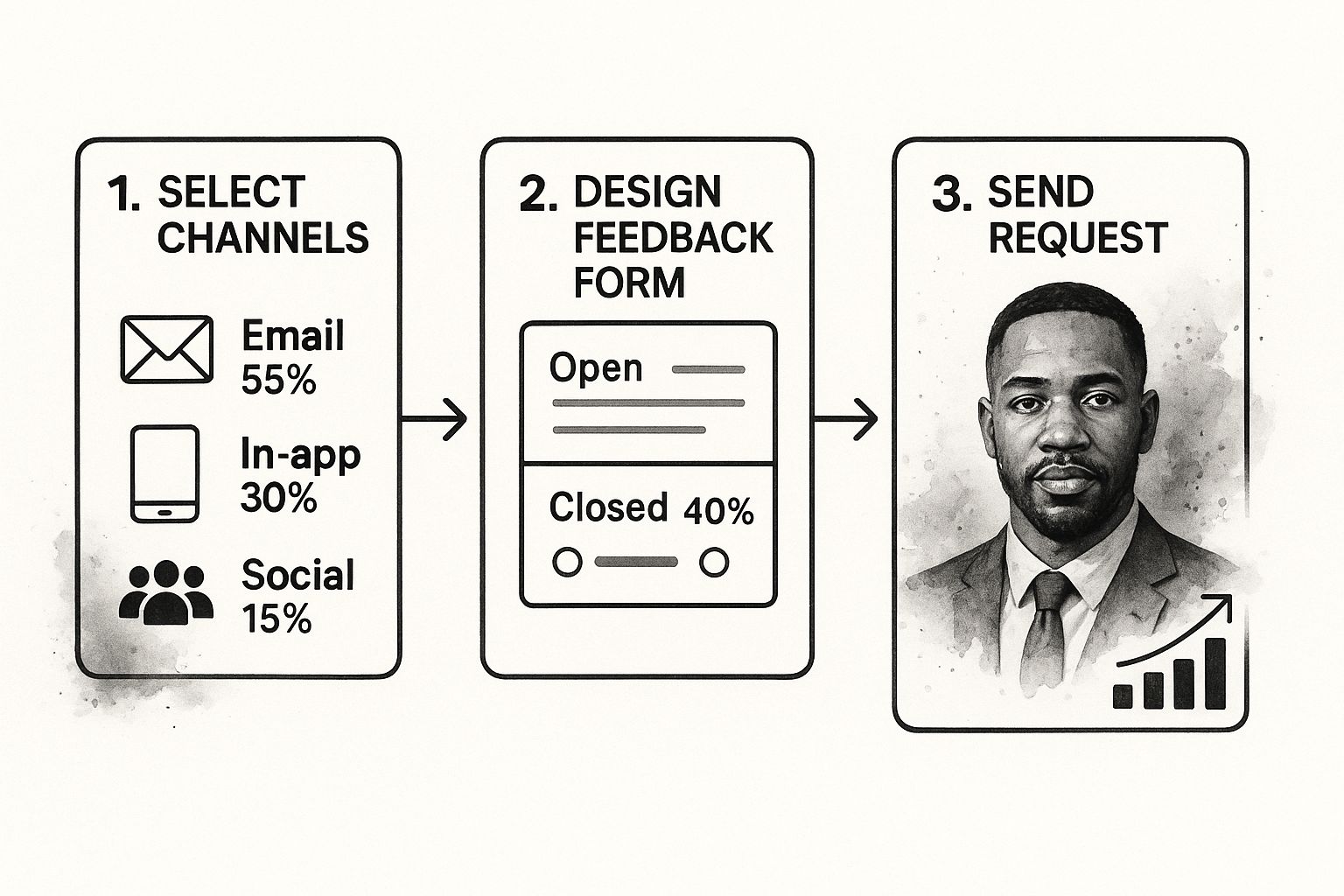You Think You Know How to Ask Customer Feedback? You Don't.
Learn how to ask customer feedback effectively. Discover proven methods on how to ask customer feedback to improve your business and boost growth.
Posted by
Related reading
Ignore Your Customers and Die Poor: A Founder's Guide to Customer Sentiment Analysis Tools
Discover the best customer sentiment analysis tools to understand your audience, improve satisfaction, and drive growth. Start making data-driven decisions today!
Your Customer Feedback Is a Goldmine. Stop Treating It Like a Landfill.
Discover the best customer feedback analysis tools in 2025 to boost insights, improve satisfaction, and accelerate your business growth. Explore now!
You Don't Have a Product Problem, You Have a Listening Problem.
Stop guessing. Here are 10 brutally honest ways to collect customer feedback that actually work. A battle-tested founder's guide, no fluff included.
Alright, let's cut the crap. You're probably here because some investor told you to "listen to your customers," and now you're dutifully googling how to do it without wanting to gouge your eyes out. Here’s the hard truth nobody admits: most customer feedback is garbage. It's vague, polite, and completely useless. But buried in that mountain of noise are the few golden nuggets that will determine whether your startup lives or dies. Your job isn't to ask for feedback; it's to hunt for the truth.
Why Your 'Happy' Customers Are About to Churn
That "Satisfied" metric on your dashboard? It's a vanity metric. A lie you tell yourself to sleep better at night. Silence from customers doesn't mean they're happy. It means they're silently demoing your competitor's product.
I almost lost a six-figure client because I mistook their silence for satisfaction. Our dashboards were all green—CSAT scores were stable, no angry tickets. We thought we were killing it. Then, out of nowhere, their renewal was "under review."
They weren't mad. They were just quietly shopping because we'd stopped solving their evolving problems. In their eyes, we had become legacy software, all while our metrics were telling us we were winning.
Takeaway: Silence isn't golden. It's the sound of your customers ghosting you for someone better.
The Myth of the Satisfied Customer
"Customer satisfaction" is a trap set by corporate drones. A satisfied customer is just someone whose bare-minimum expectations you've met. You don't build a world-beating company by meeting the minimum. You build it by creating fanatics, and fanaticism is forged in the fire of proactive problem-solving, not checking a box.
The data is terrifying. 57% of customers will switch to a competitor after just one bad experience. Read more about the brutal reality of customer experience if you want to lose some sleep tonight. More than half your user base has one foot out the door, just waiting for you to slip up.
When you aren't actively digging for feedback, here's what's really happening:
- You're ignoring the papercuts. The tiny frustrations in your UX that stack up until the user bleeds out and churns.
- Your competitors are having the conversations you're not. They're mining your customers for the pain points you think don't exist.
- You're building in an echo chamber. Your roadmap is based on your team's assumptions, not your customers' reality. That's a direct flight to building a product nobody wants.
Your current feedback "strategy"—or lack of one—is a time bomb. It’s not if it will blow up your churn rate, but when.
Takeaway: Ignore your customers, and you’ll be lucky to survive the quarter.
How to Frame Questions That Get Real Answers, Not Polite Lies

Stop asking useless questions. If your survey still asks "How would you rate us from 1-10?" just do everyone a favor and delete it. You'll get a '7' with no context, feel productive for five minutes, and learn nothing. It’s a complete waste of everyone's time.
The quality of feedback you get is a direct reflection of the quality of your questions. Lazy questions get lazy answers. Corporate-speak questions get polite, useless lies. You're not trying to get a good grade on a report card; you're on a black ops mission to extract actionable intelligence.
Takeaway: Useless questions create useless data, which leads to building useless products.
Ditch Satisfaction. Hunt for the ‘Job.’
Nobody wakes up thinking, "I really hope a SaaS product satisfies me today." They wake up with a problem that’s driving them insane. A workflow that’s broken. A process that’s bleeding money. They "hire" your product to do a job. Your mission is to figure out what that job is.
This is the whole "Jobs-to-be-Done" thing, minus the consultant fluff. It's about digging into the real motivation.
Here’s the difference:
- Useless Question: "Are you satisfied with our product?" (Gets a meaningless "yes/no.")
- JTBD Question: "What problem were you trying to solve when you first found us?" (Instantly reveals their pain and use case.)
And again:
- Useless Question: "How likely are you to recommend us?" (This NPS score is a lagging indicator, not a map for the future.)
- JTBD Question: "What finally broke in your old workflow that made you go looking for a solution like ours?" (Uncovers the trigger event and your real competition—which is usually a chaotic spreadsheet.)
These questions reframe the conversation from being about your product's features to being about your customer's life. That's where the gold is. The most dangerous feedback isn’t negative; it’s vague. Vagueness is where bad assumptions are born, and assumptions are how startups die. Get specific or get out.
If you’re still stuck, check out some powerful NPS question examples that go beyond the tired old format. Even standard metrics can be supercharged if you stop being lazy.
Takeaway: Stop asking about your product and start asking about their problem.
The Right Time and Place: How to Ask Without Being Annoying
Timing is everything. Ask at the wrong moment, and you're a telemarketer calling during dinner. You're just noise. But catch someone at the right moment? You're a mind-reader.
Stop the "spray and pray" email survey blasts. It’s not about asking more; it's about asking at the precise moment their experience is fresh and their emotions are raw.
The Moments That Actually Matter
Stop guessing. There are specific, high-leverage moments where users are practically bursting with honest feedback. Your job is to be there to catch it.
- The "Moment of Success": Right after they achieve a win with your product—they export their first report, close their first deal—hit them with a small in-app prompt. "What did you just accomplish?" They're feeling good; they'll associate that win with you.
- The Post-Cancellation "Exit Interview": This is a goldmine most founders are too scared to touch. When a customer cancels, they have zero reason to lie. An hour later, send a plain-text email from you, the founder: "I'm the founder and I'm bummed to see you go. If you have 30 seconds, what was the one thing we could have done better?" The response rate will shock you. It feels human.
- The "Founder" Check-in: My secret weapon. Two weeks after signup, I send a simple, plain-text email. Subject: "Checking in." Body: "How's it going with [Product Name] so far?" People feel an obligation to reply to a real person, not a marketing bot.
The goal isn't to blast everyone. It's to create an invisible system for harvesting insights when customers are at their emotional peaks—either ecstatic or furious.
High-Impact vs. Low-Impact Channels
| Founder-Level Channel (High Impact) | Corporate-Drone Channel (Low Impact) | Why It Works (Or Doesn't) |
|---|---|---|
| In-app prompt at a "success" moment. | Generic "Rate our app" pop-up. | Context is king. One is tied to a specific win; the other is a random, annoying interruption. |
| Personal plain-text "founder" email. | Branded HTML email with a survey link. | Authenticity wins. A real question from a real person gets a real answer. A corporate email gets deleted. |
| Post-cancellation "exit interview" email. | "We're sad to see you go" automated drip. | Timing and tone matter. Asking for candor after the decision feels genuine. A pre-cancellation plea feels desperate. |
Choose the channel where their feedback is most potent, not where it's most convenient for you.

This strategic approach is critical. A recent XM Institute study found that while global satisfaction is a stable 76%, loyalty metrics like trust and repurchase intent are dropping. That gap proves satisfying customers isn’t enough. You have to actively engage them to build loyalty that survives. Read the full research on global customer loyalty to see how fragile "satisfaction" really is. For more ideas, explore other ways to collect customer feedback.
Takeaway: Don't ask for feedback when it's convenient for you; ask when it's meaningful for them.
Turning Raw Feedback Into a Roadmap That Prints Money

So you opened the floodgates and now you're drowning in feedback. Great. Getting it is the easy part. The real work is turning that chaotic mess of ideas, bug reports, and feature wishes into a coherent plan.
This is where most founders fail. They either get paralyzed and do nothing, or they frantically chase every new idea. Both lead to the same dead end: a bloated, unfocused product that solves nothing.
Your job isn't to be a short-order cook, building every feature someone requests. Your job is to be a detective, finding the single, underlying problem that dozens of different feature requests are pointing to.
Finding the Signal in the Noise
Before you touch any fancy prioritization framework, your first job is pattern recognition.
Here’s a no-BS way to triage what comes in:
- Bugs: Is something broken? This isn't a feature; it's a promise you failed to keep. Fix it. Now.
- "How do I...?" Questions: This isn't a feature request. It's a flashing red sign that your UX or onboarding sucks. Clarifying your product is often more valuable than adding new complexity.
- Feature Requests: This is where you connect the dots. Tag every request with a theme. "I want a CSV export," "Can you add Zapier?" and "I need PDF reports" all go under #Integrations/Exports.
You just turned three random anecdotes into a strategic insight. Do this consistently, and a few core themes will scream at you from the chaos. This is what you build next.
Don't Ask If You're Not Going to Act (and Tell Them)
The final, most-forgotten step: close the loop.
When you ship a feature that came from user feedback, you damn well better tell the people who asked for it. A quick, personal email: "Hey, remember that feature you asked for? We just launched it. Your feedback made it happen." This is one of the most powerful retention plays you can make.
You just proved you listen. You turned a user, maybe even a critic, into a fanatic. The true measure of a feedback system is whether it leads to a better product and happier customers. Learning how to apply improving customer satisfaction using survey insights is key.
Takeaway: Don't just collect feedback; connect the dots and then tell customers you solved their puzzle.
Finding Gold in Your Voice of Customer Data

Let's kill the myth of "Voice of Customer" analysis. It’s not some complex process requiring expensive software and data scientists. It's you, a spreadsheet, and a pile of raw, unfiltered customer comments. It's digging through support tickets, interview notes, and free-text survey fields until your eyes blur. This is the grunt work. It’s not glamorous. But it’s where billion-dollar ideas are born.
This is the work that separates founders who build 'cool tech' from those who build indispensable solutions. The truth is in the trenches.
The Grimy Spreadsheet Method
Before you buy any tool, get back to basics. Dump everything into one place. Every survey response, chat log, and public review. Then, create a few columns:
- The Raw Feedback: Their exact words. Don't edit.
- The Core Problem: The real issue behind the words. "I can't export to PDF" is a request. The problem is "I need to share data with my boss who doesn't log in."
- Sentiment: Simple. Positive, Negative, Neutral, Idea.
- Theme Tags: This is where the magic is. Tag every comment: #onboarding, #buggy, #pricing, #ui-confusion, #feature-request-reporting.
Don’t overthink it. Just start tagging. After a few hundred entries, you’ll see a handful of tags dominating the list. That’s your signal. That’s your market screaming at you.
Turning Words into Actionable Numbers
Qualitative feedback feels fuzzy, but you can absolutely quantify it. With your themes tagged, just count them.
What if 42% of your negative feedback is tagged #ui-confusion? You don’t have a feature gap; you have a design crisis. If #integrations is the most frequent request, you know exactly where to point your engineers. This isn't rocket science; it's disciplined listening. For a more structured process, read this guide to Voice of Customer analysis.
Don't just look at your own channels. You can scrape reviews from Google Maps and other forums. That's where the unvarnished truth lives.
Takeaway: Stop looking for a magic tool. The most powerful insights come from getting your hands dirty with the raw language of your customers.
Final Thoughts Before You Waste Everyone's Time
Let's be brutally honest. Asking for feedback is an act of courage. You're inviting someone to tell you your baby is ugly. If your ego can't handle that, then don't even bother. You'll just waste their time and create resentment when you inevitably ignore everything they say. But if you're serious about building a business that lasts, you don't have a choice.
The Truth Doesn't Care About Your Feelings
The market doesn't care about your feelings, your long hours, or your elegant code. It cares about one thing: solved problems. Your customers, especially the complainers, are holding the map to those problems. Your job is to get that map and have the guts to follow it, even when it proves your brilliant initial idea was flat-out wrong.
That’s the real challenge. It isn’t hearing the feedback; it's accepting it. It's letting go of your vision just enough to see their reality.
Stop Building in a Vacuum
Stop pretending you know best. Stop hiding behind your roadmap and start having the conversations that matter. Every day you put this off is another day your competitors get smarter while you get more attached to your own assumptions. This is what separates companies that find product-market fit from those that perfect a product for a market that doesn't exist.
So what's the bottom line? You can learn how to ask for customer feedback the hard way—through churn and failure. Or you can start getting to the truth right now.
Takeaway: The market is talking. If you’re not listening, you're already a ghost.
Stop drowning in feedback spreadsheets and start getting clear signals—let Backsy find the truth for you so you can focus on building what matters.